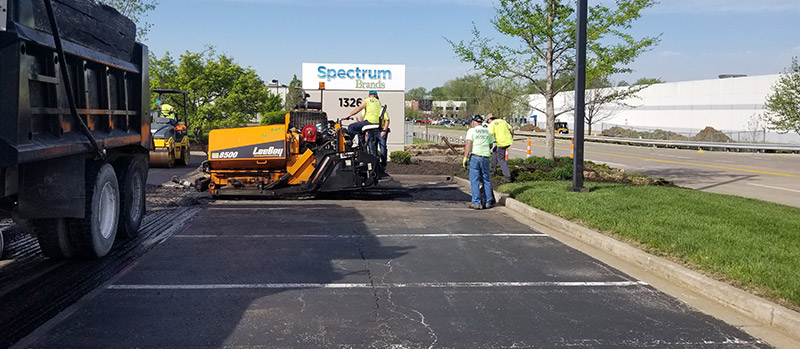Excitement About A1 Professional Asphalt & Sealing Llc
Wiki Article
The Main Principles Of A1 Professional Asphalt & Sealing Llc
Table of ContentsUnknown Facts About A1 Professional Asphalt & Sealing LlcA1 Professional Asphalt & Sealing Llc for BeginnersThe Greatest Guide To A1 Professional Asphalt & Sealing LlcThe 9-Minute Rule for A1 Professional Asphalt & Sealing LlcThe 7-Minute Rule for A1 Professional Asphalt & Sealing Llc

The oil in an auto engine is not just oil. It has a range of additives to improve the vehicle's efficiency. These include polymers, thickness modifiers, heat stabilizers, added lubricants, and put on additives. The REOB consists of all the additives that remained in the waste oil as well as the wear steels from the engine (mainly iron and copper).
Nevertheless, by making many blends utilizing different REOB samples and different asphalt binders, the variants mostly can be balanced out. Several States offered samples of known REOB structure to TFHRC researchers, who examined the examples to contrast the percent of added (known) REOB to the found (evaluated) amount. The analyses showed a similar portion of added and found REOB.
A1 Professional Asphalt & Sealing Llc for Beginners
None of those States recognized that the asphalt they were getting included REOB. One State urged its samples had no REOB - https://tan-clementine-c1e.notion.site/A1-Professional-Asphalt-Sealing-LLC-Your-Partner-in-Asphalt-Excellence-008846ab43034802b3108685780f7505.Of the 1,532 samples evaluated, 12 percent contained REOB, and some had appreciably high degrees of it at 1020 percent. The greatest level was 34 percent in an example from Texas, which TxDOT had used in a patching substance. This testing also disclosed the presence of phosphoric acid in 11 percent of the examples, and 2 percent included ground tire rubber.
Two years ago at TRB's yearly meeting, the Federal researchers held an REOB workshop and provided the findings of their research laboratory examinations to a standing room-only crowd. Although some agencies do not particularly prohibit REOB, they do impose physical tests that avert its useeffectively a ban. a1 professional. Others do not outlaw it by specification, yet have agreements with asphalt distributors to avoid making use of REOB
Facts About A1 Professional Asphalt & Sealing Llc Uncovered
A handful do allow REOB, some within certain limitations. Ohio and Texas restriction degrees to much less than 5 percent of the asphalt. To create a reputable examination approach that all States can use, the TFHRC researchers set up a round-robin test plan. The participants are 11 State highway agencies (Illinois, Massachusetts, Minnesota, Mississippi, Montana, North Carolina, Oklahoma, South Carolina, Texas, Vermont, and Wyoming), 2 independent testing labs, the Ministry of Transport in Ontario, Queen's University in Ontario, and an Ontario paving specialist.In total amount, the researchers prepared and delivered 720 blends. The participants are evaluating the samples independently utilizing the guidelines provided by the TFHRC scientists. The round-robin screening is almost completed, and TFHRC is in the procedure of accumulating the outcomes. The output will be a recommended AASHTO examination technique that any State can adopt and make use of (a-1 asphalt).
The sidewalk with REOB, which lies 0.6 mile (1 kilometer) from the sidewalk without REOB, has similar subgrade, traffic thickness, and climate. The section of Highway655 with 5 to 10 percent REOB showed substantial splitting. In this example, the existence of REOB was the determined source of breaking at a low temperature levels.
"In our experience in copyright, even tiny quantities of 23 percent can be an issue." An area of test pavement in Minnesota (MN1-4) located to include REOB also split prematurely. The sidewalk done well for the first 3 to 4 years, however after that started to break. This sidewalk is also based on reduced temperatures.
A1 Professional Asphalt & Sealing Llc - Questions
The examinations were not extensive, but they showed that at degrees of 6 percent or even more, the tensile stamina of the asphalt went down dramatically. At a degree of 3.5 percent REOB, the variant in the physical test techniques was above the effect of REOB. Actually, it was difficult for scientists to analyze whether REOB was existing.

One binder parameter considered is the distinction in between the low temperature critical requirements temperature level for tightness (S) in the bending light beam rheometer and the flexing beam rheometer creep incline (m-value) noted as Tcritical. Two independent study groups, one from AASHTO and the other from the Asphalt Institute, concluded that even more research study is needed on the usage of REOB in asphalt.
Formerly, all asphalt screening determined engineering buildings such as stiffness. These tests do not show what products had actually been contributed to the asphalt. One sample gotten during the TFHRC research had a very weird analysis. The example had the complying with examination results: Superpave PG 64-28 with a heat grade of 67.3 Tcritical on the flexing beam rheometer was 6.7 levels Celsius.

All about A1 Professional Asphalt & Sealing Llc
These results demonstrate there are weak points in the standard engineering testing protocols that might be manipulated. The manufacturer may have an economic advantage and the item passes all the standard examinations, but the product might not be beneficial to ensuring lasting efficiency. To resolve this problem and the expansion of brand-new asphalt ingredients and extenders, TFHRC is starting a study program to make use of handheld spectroscopic devices, x-ray fluorescence spectroscopy, and Fourier change infrared spectroscopy to allow analyses to be carried out in the area rather than needing to take examples back to the lab.Report this wiki page